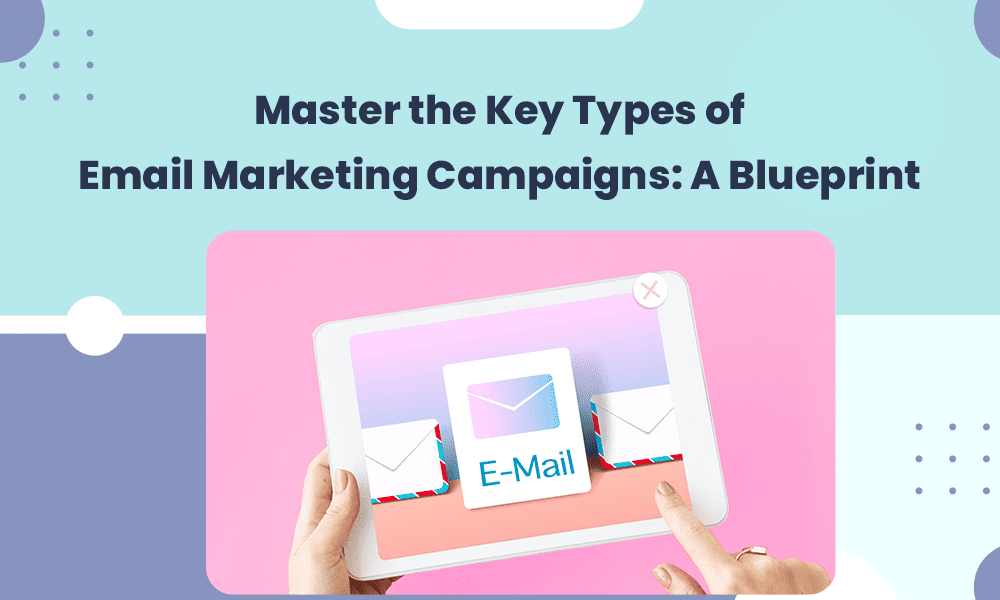How many types of email marketing are there? Well, the major types of email marketing include:
- The welcome email series
- Post-purchase (retention) emails
- Social media connect emails
- The ‘brand story’ email
- The triggered email sequence
- Newsletter emails
- Seasonal email campaigns
- Cart abandonment emails
- The re-engagement email sequence
- Product update emails
- Internal update emails
- The ‘new content’ announcement
- Video email marketing
- Review request emails
- Event invitation emails
- Referral emails
- ‘Thank you’ emails
- Milestone emails
- Cross-sell emails
In this article, you’ll discover all the important types of email marketing campaigns you must master for extraordinary marketing results.
We’ve also shared insights like the right time to send your emails. The article also covers some great email marketing examples to learn from.
Table of Contents
Email Marketing Statistics in a Nutshell
Before we begin, let’s look at individual email marketing statistics. Statista states global email users are estimated to grow to 4.6 billion in 2025.
Approximately 306 billion emails are sent and received daily worldwide, with individuals receiving, on average, 96 emails daily, 33 of which go unread.
So, to stand out in your audience’s inbox, you must send targeted emails to a specific audience at the right time. This way, you effectively nurture leads, build brand awareness, and drive revenue.
Read also: How to Run Targeted Email Marketing Campaigns For High ROI
19 Types of Email Marketing Campaigns To Master
Now, let’s get into the details of all the important types of email marketing. If we are to sell (anything) online, we must master these types of emails.
1. The welcome email series
This is one of the most critical components of an effective email marketing strategy. It is a sequence of email series sent to new subscribers after signing up for your email list.
This series aims to introduce your brand to your audience, build trust, and encourage engagement with your content.
But a welcome email series is much more than just a polite greeting. It’s an opportunity to make a great first impression and set the tone for your relationship with your new subscribers.
On average, welcome emails have a 50% open rate, meaning that over 75% of people are likelier to open these messages than other marketing emails.
So, what makes a great welcome email series? Here are some quick ways to create a compelling series:
- Personalization is vital. 80% of consumers will only buy from a brand that personalizes its messages. In addition, personalizing subject lines can lead to a 50% higher open rate. A way to personalize your emails is by sending relevant messages to your subscribers to celebrate their special days, such as Anniversaries, Birthdays, or Milestone achievements.
- Keep it simple. Your welcome emails should be easy to read and understand. Use simple language and focus on one or two key messages in each email. Always remember, less is more.
- Show your personality. Your welcome email series is an excellent chance to showcase your brand’s personality and voice. Don’t be afraid to be authentic and inject humor or personality into your emails.
- Include a clear call to action. Your welcome email series should include a clear call-to-action that encourages subscribers to take action, whether to read your latest blog post, follow you on social media, or purchase.
On EngageBay, you can choose from a series of ready-to-use, attractive email templates to find the best pick for your email needs.

2. Post-purchase emails to drive customer retention
Getting customers to purchase is just the first step as an online retailer. The real challenge is getting them to come back for more.
That’s where post-purchase emails come in. They are automated emails to engage customers after purchasing, encouraging them to return to your store repeatedly.
So, this is critical to your business’s success because reports show that repeat customers are 9x more likely to purchase than first-time shoppers.
Additionally, Post-purchase emails are effective for several reasons. First, they allow you to thank your customers for their purchases and show appreciation for their business. This gesture can go a long way toward building customer loyalty and fostering a healthy relationship.
Second, you can use post-purchase drip emails to upsell or cross-sell related products. For example, if a customer buys a pair of shoes from your online store, you could send them an email suggesting a matching handbag or accessories. This increases the likelihood of a repeat purchase and helps personalize the customer’s shopping experience.
You can also use Post-purchase drip emails to gather valuable customer feedback. By asking your subscribers to rate their experience or leave a review, you can gain insights into what’s working well and where to improve.
It’s best to send post-purchase email campaigns immediately after purchase.
Here’s an example of a post-purchase email.

Read also: 21 Email Newsletter Software: What’s Hot in 2024?
3. Social media connect emails
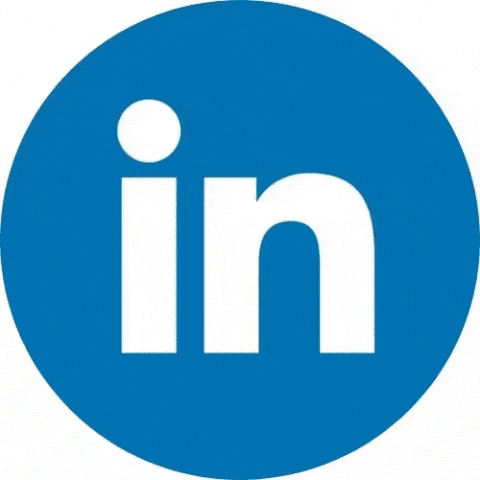
Social media has become integral to our lives. That’s why connect-via-social campaign email is crucial for your business’s success.
Connect-via-social campaign email is an email marketing strategy allowing subscribers to connect with you on social media platforms.
Every email marketer aims to maximize touchpoints with subscribers and prospects and consistently look for ways to connect with subscribers on other platforms.
One way to do that is by sending connect-via social campaigns. This type of email works best for new subscribers or leads you are nurturing. If your business just launched its media platforms, it may be an excellent time to send out connect-via-social campaign emails.
The Connect-via-Social Campaign Email strategy also helps you build brand awareness and increase engagement. By including social media buttons and links in your email campaigns, you encourage your audience to follow your social media accounts and engage with your content. This, in turn, can lead to increased website traffic and conversions.
Here’s a template for you to use as the content for your email asking your new subscribers to connect with your brand on social media 👇🏻
| Dear {Name},
As a valued community member, we invite you to join us on social media. Our social media channels are the perfect way to stay up-to-date with our company’s latest news and information and connect with other fans and customers. You’ll get exclusive content, sneak peeks, and special promotions by following us on Facebook, Twitter, and LinkedIn. You’ll also be able to share your feedback, comments, and suggestions with us, helping us improve and grow as a company. To become a part of our social media family, click on the links below: {Insert links to social media profiles} We look forward to connecting with you on social media and updating you on our latest news and developments. Best regards, {Your brand signature} |
How To Write a Winning Introduction Email
4. The ‘brand story’ email
Brand story emails are a powerful tool for connecting with your audience and creating meaningful relationships. These emails share the history and values that underpin your brand, allowing customers to connect on a deeper level beyond just the products or services offered.
When done right, brand story emails can be incredibly compelling, engaging, and emotionally appealing.
So, how can you create a compelling brand story email?
- Start with your brand story: Before creating a brand story email, you need to know your brand story. What are your company’s origins? What are your values? What makes your brand unique? Spend time crafting your brand story, so you have a straightforward narrative to share with your audience.
- Focus on the human element: People connect with people, so be sure to share the stories of the individuals behind your brand. For example, share stories of how your company has impacted people’s lives or how your products or services have helped to solve a problem.
- Use visuals to enhance your story: Visuals can enhance your brand story, making it more engaging and memorable. Consider using images or videos to help bring your brand story to life.
- Be authentic and transparent: Transparency and authenticity are critical when sharing your brand story. Be honest about your company’s history, values, and goals. Share both the successes and the challenges you’ve faced along the way.
Need ideas on the kind of brand story emails to send? We’ve got you covered. Here is a list of types of brand email stories you can send.
- The values story: This type of brand story email focuses on the company’s core values and what they stand for. For example, a sustainable fashion brand might share its commitment to ethical manufacturing practices and reduce its environmental impact.
- The milestone story: This type of brand story email celebrates a significant milestone in your company’s history. For example, you can share a retrospective of your most significant accomplishments over the past decade.
- The customer success story: This type of brand story email highlights how your company’s products or services have helped customers achieve their goals or overcome challenges. For example, if you run a fitness brand, you might share a story of how a customer lost significant weight and improved their health through using your products.
- The employee story: This type of brand story email focuses on the people behind the brand. For example, if you run a software company, consider sharing the story of one of your employees and their journey to becoming a software developer or a team member.
Regardless of the type of brand story email, the goal remains constant to get a personal and emotional connection with your subscribers while reinforcing the brand’s values and mission.
However, the trick is to limit the sending of this category of emails to quarterly or bimonthly. Sending it less frequently yields better results.
Here’s an example of a brand story email to draw inspiration from 👇🏻

Read also: Email Anatomy 101: Essential Email Parts You Shouldn’t Ignore
5. The triggered email series
These are automated emails sent out to specific email segments after being triggered by a particular action.
Rather than sending generic, one-size-fits-all messages to your entire email list, triggered email series use customer data and behavior to deliver personalized, relevant messages at just the right time.
As a result, these campaigns effectively engage customers and drive conversions, making them a valuable addition to any business’s marketing toolkit.
Types of triggered emails include:
- A welcome series email for new email subscribers.
- A ticket confirmation email for subscribers who signup for your event.
- A product guide for customers who made a recent purchase.
Once you have identified your triggers, you can create campaigns triggered by those actions. A triggered email series’s most significant advantage is creating personalized responses to a subscriber’s action.
You can create triggered emails for free using EngageBay’s excellent email marketing CRM.
Here’s how a triggered email sequence for a fitness studio might look like 👇🏻
Trigger: New Member Signup
Email 1 (sent immediately after signup): Welcome email + Overview of studio facilities and services.
Email 2 (sent two days after email 1): Introduction to the studio’s instructors, their specialties, and a recommended class schedule based on the member’s goals and fitness level.
Email 3 (sent five days after email 2): Educational content on fitness and wellness topics (e.g., nutrition, injury prevention, mental health) and how the studio can help members achieve their goals.
Email 4 (sent 10 days after email 3): Invitation to a member-only event, such as a private class or workshop, to help them feel part of the community and connect with other members.
Email 5 (sent 15 days after email 4): Feedback request to learn more about the member’s experience and make necessary adjustments.
Here’s a video to create automated email sequences for your marketing campaigns in EngageBay. If you prefer a text guide, click here.
10 Best Trigger Email Marketing Campaigns (+ 5 Top Software)
6. Newsletters for marketing
This category of emails has stood the test of time. According to a HubSpot study, 81% of B2B marketers report email newsletter is their most used form of content marketing.
An excellent newsletter can distinguish between building a loyal following and being ignored in a sea of emails.
Fortunately, crafting a compelling newsletter email is possible and can be incredibly effective with the right strategy and approach.
A newsletter email is highly beneficial in keeping your subscribers up-to-date on new products, promotions, and upcoming events.
For example, if you’re a fashion retailer, you could send a newsletter to your subscribers featuring the latest fashion trends, new arrivals, and exclusive promotions. In addition, this could include high-quality product images, descriptions, and links to purchase items directly from the email.
Another example of when a newsletter email is highly beneficial is when you want to establish your business as a thought leader. For instance, a digital marketing agency could send out a newsletter email to its subscribers with industry insights, tips, and best practices for digital marketing.
In addition, this email could include links to blog posts or whitepapers, providing subscribers with valuable information that can help them improve their marketing efforts.
In both instances, newsletter emails can be highly beneficial because they keep subscribers engaged with the brand, provide valuable information, and offer opportunities for subscribers to make purchases or take other actions that benefit the business. It works best to send newsletters monthly to keep your subscribers informed.
Here’s a great example of an email newsletter by Asana 👇🏻
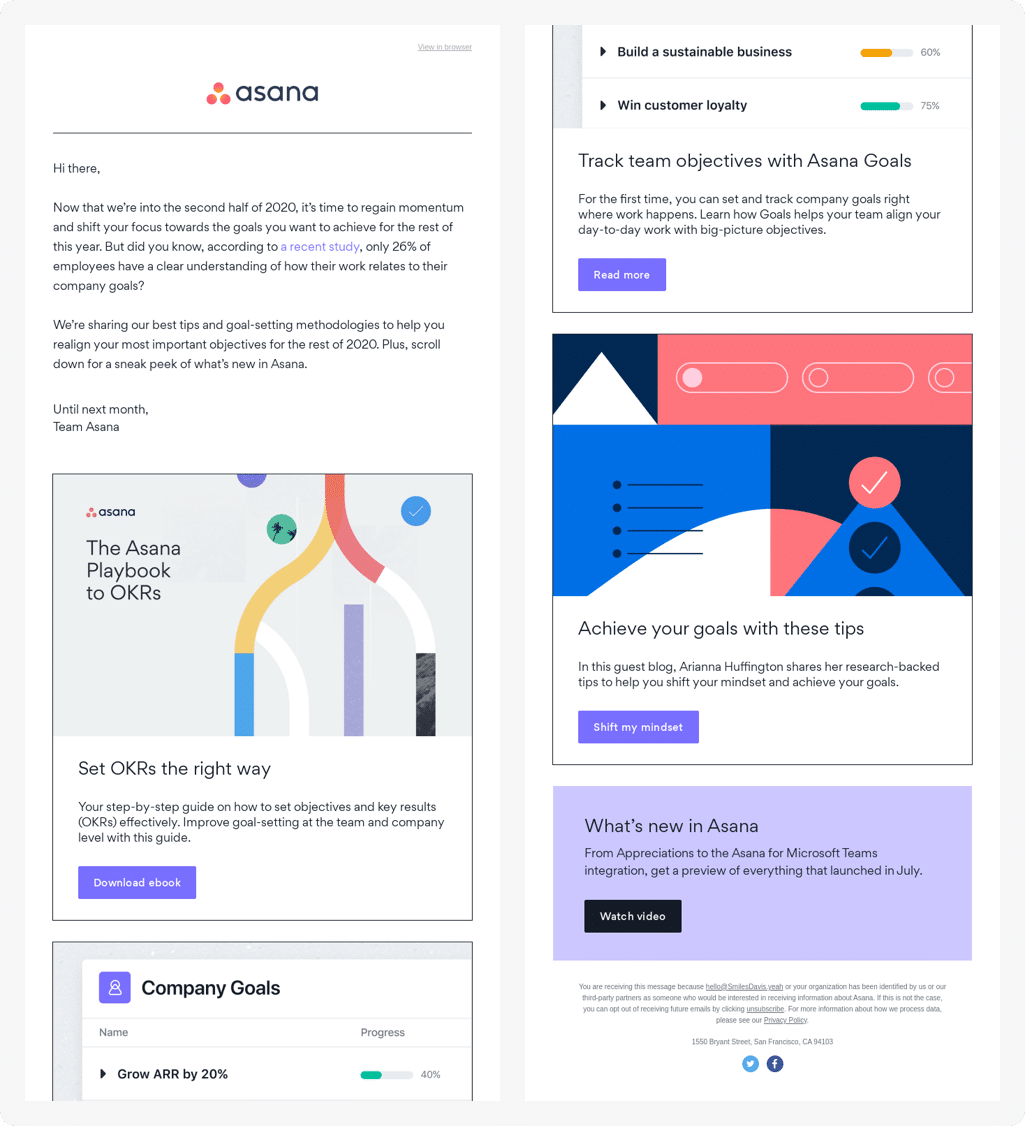
14 Inspiring Newsletter Sign-Up Examples From Top Brands
7. Seasonal campaigns
They are a great way to tap into the year’s natural rhythms and personally connect with your customers. Whether it’s the Winter holidays, Black Friday, Valentine’s Day, or Easter holidays, seasonal campaigns help you create excitement and a sense of urgency around your brand and product offering.
Even better, in such seasons, people are more willing to spend. As a result, you increase your chances of closing sales by sending out timely seasonal campaigns.
For example, for Easter, consumers plan to spend, on average, $179, amounting to a collective spend of $21.6 billion in the US alone.
With the right approach and messaging, you can capitalize on the excitement and anticipation of seasonal events and turn them into a profitable tool to drive sales.
For instance, a jewelry brand might send a Mother’s Day email campaign in the weeks leading up to the holiday to promote their pieces as the perfect gift for moms.
The email might feature heartwarming stories about moms, gift recommendations for different types of moms (e.g., “Gifts for New Moms,” “Gifts for Working Moms”), or a special promotion for mums.
One key aspect of successful seasonal campaigns is relevance. Customers are likelier to engage with content relevant to their lives and experiences.
For example, a back-to-school campaign that targets college students will be different from a campaign targeting parents of young children. Understanding your audience and crafting content that meets their needs is critical to making seasonal emails work for you.
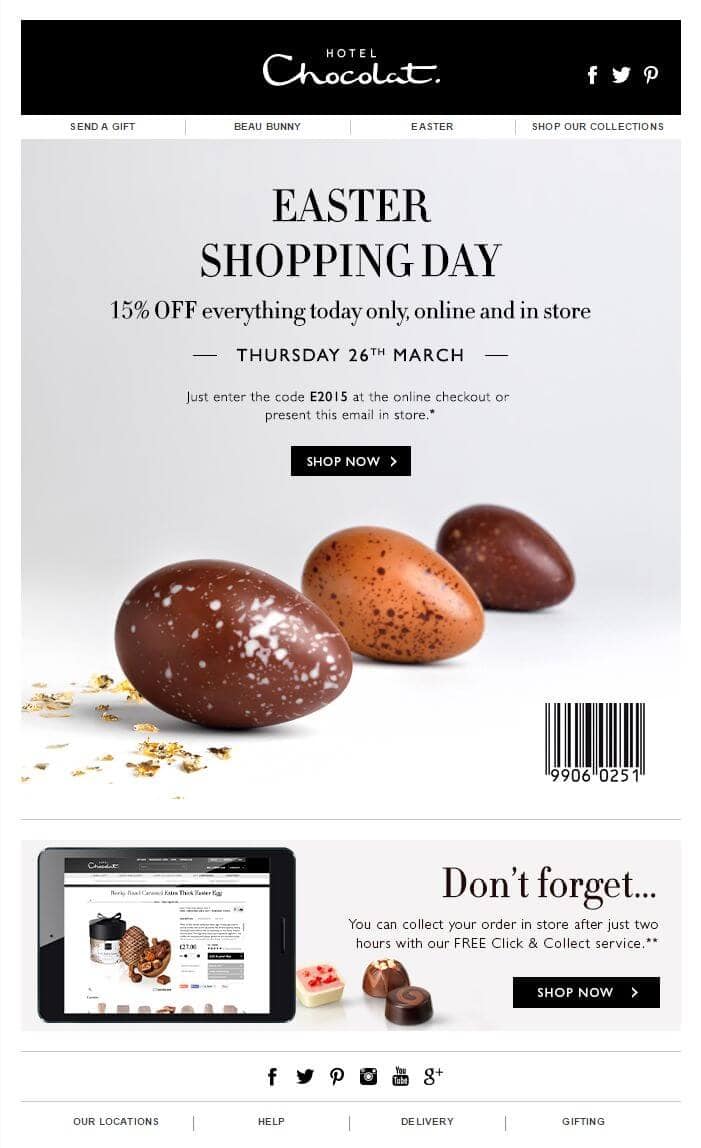
Read also: 15 Email Sequence Software To Ignite Your Campaigns
8. Cart abandonment email series
Cart abandonment is a frustrating reality for eCommerce retailers.
As per a Baymard Institute study, the average cart abandonment rate is around 70%, which means that for every ten customers who add items to their cart, only three complete the purchase.
Fortunately, there’s a way to win back significant lost sales through the abandoned cart email series. These automated email campaigns are sent to customers who abandon their carts, reminding them of the items they left behind and encouraging them to complete their purchases.
Ideally, you should send out your first abandoned cart series within an hour of the customer leaving their cart. The second email in the series should be sent 24 hours later, and the third one should be sent 48 hours after the second one.
This email should remind them of the items they left behind and encourage them to complete their purchase.
Before crafting an abandoned cart email series, it’s essential to understand why customers abandon their carts in the first place. Common reasons include unexpected shipping costs, complicated checkout processes, comparison shopping, or getting distracted during a purchase.
Here are some abandoned cart email series templates for eCommerce 👇🏻
Email 1: Reminder
| Subject line: You left something in your cart!
Hello {Customer Name}, We noticed you left some items in your cart on our website and wanted to remind you of them. So make sure to take advantage of the things you love! Click the button below to return to your cart and complete your purchase. <Button: Return to Cart> Thank you for considering our store. Best regards, {Your Store} |
Email 2: Make an offer
| Subject line: Get 10% off your abandoned cart!
Hello {Customer Name}, We noticed you left some items in your cart and wanted to offer you a special discount. So, as a thank you for considering our store, we’re offering you 10% off your entire purchase only if you complete your purchase now. Click the button below to go back to your cart and complete your purchase, and your discount will be applied at checkout. <Button: Return to Cart> Best regards, {Your Store} |
Email 3: Create urgency
| Subject line: Last chance to complete your purchase!
Hello {Customer Name}, This is your last chance to complete your purchase! We noticed that you left some items in your cart, and we want you to take advantage of them. But hurry, your items will only be reserved for a while! Click the button below to return to your cart and complete your purchase before it’s too late. <Button: Return to Cart> Best regards, {Your Store} |
The first email is a simple reminder that the customer left items in their cart and encourages them to complete their purchase. The second email offers a discount to incentivize the customer to complete their purchase.
Finally, the third email creates urgency by letting customers know their items won’t be reserved forever.
Read also: From Lost Sale to Sure Sale: Mastering the eCommerce Abandoned Cart Email
9. The re-engagement campaign
These are powerful email series designed to reconnect with inactive subscribers and reignite their interest in your brand. These emails are specifically designed to target subscribers who have not engaged with your company’s emails for up to 90 days, prompting them to take action.
Let’s say you run an online clothing store and have noticed many subscribers last engaged with your emails over three months. You decide to launch a re-engagement campaign to encourage these subscribers to come back and start shopping again.
In your re-engagement campaign email, you acknowledge their inactivity and express your concern.
For example, you might say, “We haven’t heard from you in a while and wanted to ensure everything is okay. We value you as a customer and want to ensure you get the most out of our store.”
Next, you could offer an incentive such as a 10% discount on their next purchase or free shipping on their next order.
For example, you might say, “As thanks for your continued support, we’d like to offer you 10% off your next purchase with us. Use the code WELCOME10 at checkout.”
To make your email visually appealing and easy to read, you could use high-quality images of your products and make sure the layout is clean and uncluttered.
Overall, this re-engagement campaign email can be a powerful way to reconnect with inactive subscribers and encourage them to start shopping with you again.
Here’s an example of a re-engagement email 👇🏻

Read more: How Email Marketing Can Fuel Your Overall Inbound Strategy
10. Product update email
Product update emails announce new product releases or updates on existing products. These emails provide an opportunity to showcase the value of your product, highlight new features or enhancements, and keep your customers engaged and excited about what’s to come.
Suppose you run a social media management platform, and you’ve just launched a new feature that allows users to schedule Reels on Instagram. In your product email, you might start by acknowledging the challenge of creating and publishing Reels in real-time and how the new feature will help to solve this problem.
Next, highlight the update’s essential features, such as previewing Reels, selecting a cover image, and scheduling posts for optimal engagement. Finally, use visuals such as screenshots or videos to show how the new feature works and provide a clear understanding of what the update offers.
To make the email more personalized, segment your email list and tailor the message to each customer’s needs.
For example, if the update is geared towards a particular industry or customer type, ensure your messaging is targeted to address their pain points.
B2B Email Marketing Examples From Billion Dollar Companies
11. Internal updates
Internal update emails provide a way to keep employees informed and aligned with your brand’s progress. In addition, these emails are essential for promoting transparency and fostering a culture of collaboration and open communication within the organization.
Here’s a template you can use for internal update emails 👇🏻
| Subject line: Update on the XYZ Project
Dear {Team member name}, I want to update you on the XYZ Project, which has been our focus for the past few months. We’ve made some significant progress and are excited about what’s ahead. First, I want to thank everyone for their hard work and dedication. As a result, we completed the project’s initial development phase on time and within budget. Our client is delighted with our work so far, and we’re looking forward to presenting our final product to them in the coming weeks. Moving forward, we’ll be transitioning into the project’s testing phase. This is critical to ensure the product works correctly and meets our client’s needs. But, again, we’ll need your continued support and attention to detail to ensure we get this right. If you have concerns or questions about the project or the testing phase, please don’t hesitate to contact the project team. We value your input and feedback and want to ensure we’re all on the same page as we move forward. Thank you again for your hard work and dedication. I’m looking forward to seeing what we can accomplish together. Best regards, {Your Name} |
14 Key Email Marketing KPIs Every Marketer Should Master in 2023
12. New content announcements
New content announcement emails are a great way to promote your latest content to your audience. Whether it’s a new blog post, product launch, or ebook, an email can help you generate excitement and drive traffic to your website or landing page (sign up for EngageBay’s free landing page builder).
The email typically includes a subject line that grabs the reader’s attention and gives them an idea of what the content is about and a brief introduction that explains the purpose and value of the new content.
The body of the email usually contains a teaser or summary of the new content, along with a link to where the user can access it. This link could lead to a blog post, a landing page, a video, or any other type of content.
Read also: Email Design Best Practices: Do Your Designs Convert?
13. Video email marketing
By attaching a video in an email, you increase the CTR by 200-300% increase in CTR. As a result, this means that video in your emails can be a highly effective way to drive traffic to your landing page or website.
Video emails have become increasingly popular in engaging with audiences because they offer a unique combination of visual and auditory cues that can convey emotion, tone, and information in a way that traditional emails simply cannot.
Send a video email to your subscribers:
- To share product tutorials
- To highlight case studies or testimonials
- To showcase your product demo
- To announce a new product or feature
With the rise of mobile devices, ensure that your video emails are optimized for viewing on smartphones and tablets. This means using a responsive design that can adjust to different screen sizes.
Additionally, aim for 1-2 minutes, and focus on delivering your key message quickly and effectively. This helps keep your viewers engaged and ensures they watch the entire video.

How to Create a Successful Welcome Email Series
14. Review request email
The last time you purchased from a new brand, you checked for online reviews and customers’ opinions on the brand in question, right?
Reviews are essential for any business that wishes to grow and improve. Whether you have an eCommerce store or a service-based company, studies provide social proof and build trust with potential customers. For example, research from the Online review space shows that 93% of users say online reviews impacted their buying decisions.
You should send out emails requesting your customers to conduct a review poll post-purchase to rate their experience with you. This review’s results also help you improve your product and customer service.
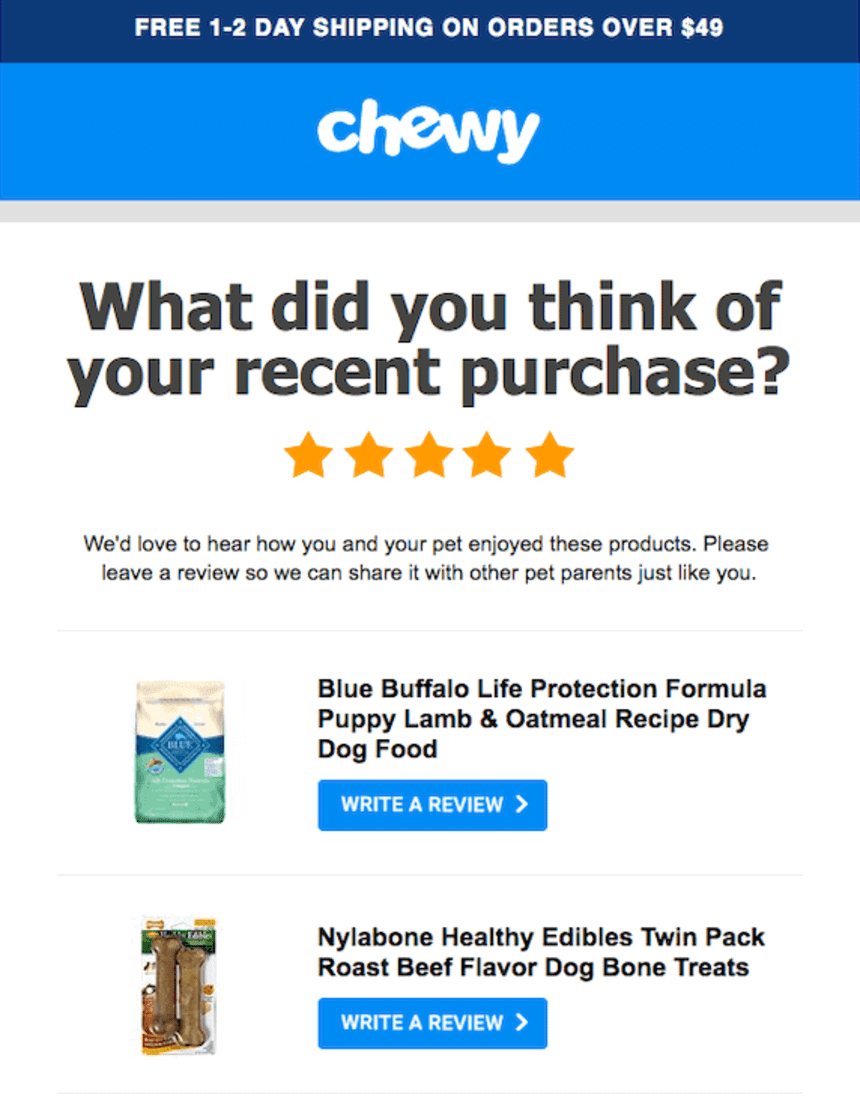
eCommerce Email Copy: 12 Tricks to Drive More Conversions
15. Event invitation emails
This type of email effectively generates buzz and excitement for your upcoming event. They provide an opportunity to share details about the event and create a sense of anticipation and urgency that encourages recipients to RSVP and attend.
The content of your event invitation email should be concise yet informative. For example, include details such as the date, time, location, and dress code (if applicable), as well as any special guests, speakers, or activities that will be taking place.
You should also include a clear call to action, such as an RSVP link or a phone number to call, to encourage recipients to take action and attend the event. You can send out event invite emails for both physical and online events.
Here’s a template you can use to invite your customers to an outdoor event 👇🏻
| Subject: Celebrating {Company Name}’s Anniversary
Dear {Name}, We are excited to announce that {Company Name} is celebrating {number of years} in business! This is a huge milestone for us, and we would like to celebrate it with our valued customers like you. Join us on {date} at {time} at {location} for a night of festivities and appreciation as we mark this momentous occasion. We will be sharing some exciting news about the future of our company and how we plan to continue providing excellent service to you. There will be {highlights of the event, such as food, drinks, entertainment, and giveaways}, so make sure to reach out to {contact} to secure your spot. We can’t wait to see you there! Thank you for your support throughout the years. We wouldn’t be where we are today without your loyalty. Best regards, {Your name} |
Here’s a template to invite customers to your online events 👇🏻
| Subject: Join us for this exclusive online event
Dear {Name}, We are excited to invite you to an exclusive online event on {date} at {time}. This event is perfect for {target audience or industry} and will provide valuable insights into {insert the topic or theme of the event}. Our expert speakers will share their knowledge and expertise on {insert the key topics that will be covered}, and there will be a live Q&A session for you to ask any questions. Click the button below to receive the link to the event: <CTA button> We look forward to having you join us and learning together. Best regards, {Your name} |
Here’s an excellent example of an event invite email from MAC 👇🏻
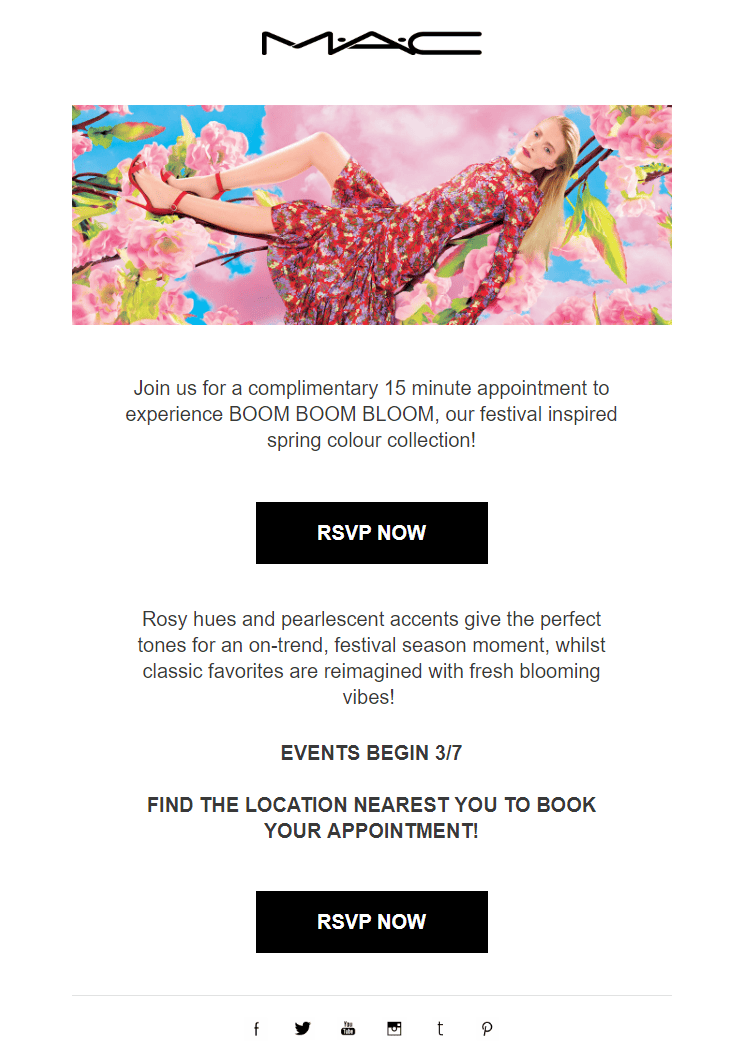
New Email Marketing Trends — Automation and More
16. Referral email
Referral emails can be a powerful tool for businesses looking to grow their customer base and increase conversion rates.
So, what exactly is a referral email? In simple terms, it’s an email that a business sends to its existing customers, asking them to refer their friends and family to the company.
For businesses, getting a referral from an existing customer can be a game-changer, leading to increased conversion rates and a loyal customer base.
But how can you encourage your customers to refer their family and friends to your business?
One effective method is to create a win-win situation by offering your customers incentives in exchange for referrals. That way, you get more qualified leads with high purchase intent, and your customers get something back in return.

Read also: A Step-by-Step Guide on Email Marketing for Small Businesses
17. Thank you emails
Thank you emails are powerful. They show customers you appreciate their patronage and value their loyalty. As per a Klaviyo study, thank you emails, on average, have an open rate of 67%.
Thank-you emails can take many forms, from a simple note to a personalized message highlighting the customer’s specific contributions to your business.
Here’s a template for your ‘Thank You’ emails 👇🏻
| Subject Line: Thank You For Your Loyalty, {Name}
Dear {Customer’s Name}, I wanted to express my deep appreciation for your loyalty to our company. We understand that you have many options for {product/service}, and we are honored that you continue to choose us. Your support and feedback have been invaluable to us. Your input helps us to improve our products and services and to serve our customers better. We take great pride in providing excellent service and are committed to maintaining the standards that have earned your trust. We know that our success depends on the satisfaction of our customers, and we are grateful for the trust you’ve placed in us. Once again, thank you for your loyalty to our company. We value your loyalty and look forward to continuing to serve you for years to come. Best regards, {Your Name} |
Read also: 15 Email Marketing Examples to Inspire Your Next Campaign
18. Milestone emails
Have you ever posted a significant win on social media? How did you feel when the congratulations were rolling in in their numbers? Great, right?
Your customers, fans, and followers deserve to experience that same excitement and recognition for their successes.
By sending a personalized milestone email to celebrate their achievements, you can create a lasting connection and inspire them to strive for greatness.
Milestone emails are marketing messages that celebrate a specific achievement, event, or milestone in your customer’s journey. These emails remind you of your brand and reinforce your relationship with your audience.
They show that you care about their experience and want to acknowledge and celebrate their progress, whether it’s a birthday, anniversary, or a significant purchase.
When your customers reach a significant milestone, such as a certain number of purchases or a particular achievement, it’s essential to acknowledge and celebrate their success. This email shows that you recognize their efforts and appreciate their continued support.
Learn Email Acquisition From 6 Strategies And 5 Examples
19. Cross-sell emails
In eCommerce, cross-sell emails are a type of email marketing that encourages customers to purchase related products or services that complement their previous purchases. These emails are sent to customers who have already purchased from a company.
The goal is to increase the customer’s lifetime value by offering them additional products or services that may complement their recent purchase.
One golden rule you must remember to ensure that your cross-selling activities drive results is that the products you are cross-selling must be complementary.
For example, suppose a customer has purchased a new laptop. In that case, the company can send a cross-sell email recommending related products, such as a laptop bag, external hard drive, or wireless mouse, that would complement their purchase.
This type of email can increase the customer’s overall satisfaction with the brand and generate additional revenue for the company.
According to a HubSpot survey, 74% who cross-sell drive up revenue by 30%.
By offering relevant and personalized product recommendations, the customer is more likely to purchase, and the company can increase the customer’s lifetime value.
Furthermore, cross-sell emails can promote seasonal or limited-time offers, discounts, or promotions.
For instance, a company that sells home decor items can send a cross-sell email to customers who have purchased a new sofa, recommending complementary items such as throw pillows, rugs, or wall art.
The email can also include a limited-time offer, such as a discount or free shipping, to encourage the customer to make an additional purchase.
Here’s a good example of cross-sell email marketing from Sambag 👇🏻
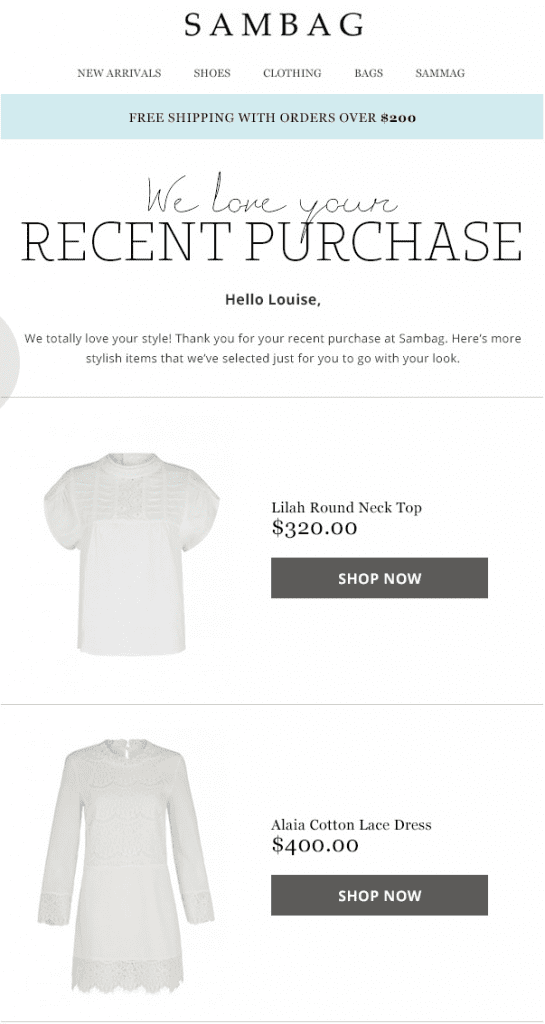
Read also: Re-Engagement Emails 101: A Guide [With Templates]
Wrapping Up
I’m excited you made it to this point. You’ve garnered insights into the types of marketing emails you should use. Now it’s time to implement and get the best results from your marketing efforts.
To streamline your email marketing efforts, try EngageBay’s all-in-one CRM platform for free to automate your email data entry, send targeted emails, and build automated workflows.
You can also eliminate miscommunication by integrating your Sales & Marketing teams on a single platform.
Additionally, with EngageBay’s excellent A/B email testing feature, you can test a variety of campaigns and send out the one that performs better for optimum conversions.
Get in touch with our team to find the right pricing plan for you.
👉Boost your email marketing success with the ultimate opt-in strategies – dive into our in-depth guide today! 🚀
